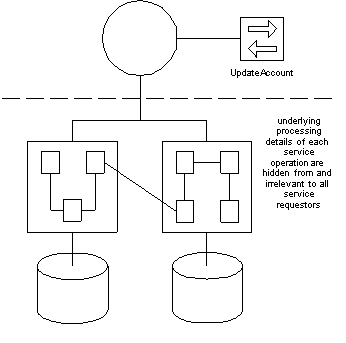|
|

|
|
Services abstract underlying logic
|
Also referred to as service interface level abstraction, it is this principle that allows services to act as black boxes, hiding their details from the outside world. The scope of logic represented by a service significantly influences the design of its operations and its position within a process.
There is no limit to the amount of logic a service can represent. A service may be designed to perform a simple task, or it may be positioned as a gateway to an entire automation solution. There is also no restriction as to the source of application logic a service can draw upon. For example, a single service can, technically, expose application logic from two different systems.
 Service operations abstract the Service operations abstract the
underlying details of the functionality they expose.
Operation granularity is therefore a primary design consideration that is directly related to the range and nature of functionality being exposed by the service. Again, it is the individual operations that collectively abstract the underlying logic. Services simply act as containers for these operations.
Service interface level abstraction is one of the inherent qualities provided by Web services. The loosely coupled communications structure requires that the only piece of knowledge services need to interact is each others’ service descriptions.
 This page contains excerpts from:
This page contains excerpts from:

Service-Oriented Architecture:
Concepts, Technology, and Design
by Thomas Erl

(ISBN: 0131858580, Prentice Hall/PearsonPTR, Hardcover, 792 pages).
For more information, visit www.soabooks.com.
|
|
|

|
|